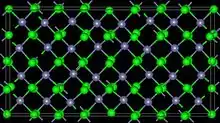Zinc iodide
Zinc iodide is a chemical compound of zinc and iodine, ZnI2. The anhydrous form is white and readily absorbs water from the atmosphere. It can be prepared by the direct reaction of zinc and iodine in refluxing ether.[1] or by reacting zinc with iodine in aqueous solution:[2]
- Zn + I2→ ZnI2
 | |
| Names | |
|---|---|
| IUPAC name
Zinc iodide | |
| Other names
Zinc(II) iodide | |
| Identifiers | |
3D model (JSmol) |
|
| ChemSpider | |
| ECHA InfoCard | 100.030.347 |
PubChem CID |
|
| UNII | |
CompTox Dashboard (EPA) |
|
| |
| |
| Properties | |
| ZnI2 | |
| Molar mass | 319.22 g/mol |
| Appearance | white solid |
| Density | 4.74 g/cm3 |
| Melting point | 446 °C (835 °F; 719 K) |
| Boiling point | 1,150 °C (2,100 °F; 1,420 K) decomposes |
| 450 g/100mL (20 °C) | |
| −98.0·10−6 cm3/mol | |
| Structure | |
| Tetragonal, tI96 | |
| I41/acd, No. 142 | |
| Hazards | |
| Safety data sheet | External MSDS |
| Flash point | 625 °C (1,157 °F; 898 K) |
| Related compounds | |
Other anions |
Zinc fluoride Zinc chloride Zinc bromide |
Other cations |
Cadmium iodide Mercury(I) iodide |
Except where otherwise noted, data are given for materials in their standard state (at 25 °C [77 °F], 100 kPa). | |
| Infobox references | |
At 1150 °C, zinc iodide vapour dissociates into zinc and iodine.
In aqueous solution the following have been detected, octahedral Zn(H2O)62+, [ZnI(H2O)5]+ and tetrahedral ZnI2(H2O)2, ZnI3(H2O)− and ZnI42−.[3]
The structure of crystalline ZnI2 is unusual, and while zinc atoms are tetrahedrally coordinated, as in ZnCl2, groups of four of these tetrahedra share three vertices to form “super-tetrahedra” of composition {Zn4I10}, which are linked by their vertices to form a three-dimensional structure.[4] These "super-tetrahedra" are similar to the P4O10 structure.[4] Molecular ZnI2 is linear as predicted by VSEPR theory with a Zn-I bond length of 238 pm.[4]
Applications
- Zinc iodide is often used as an x-ray opaque penetrant in industrial radiography to improve the contrast between the damage and intact composite.[5][6]
- United States patent 4,109,065 [7] describes a rechargeable aqueous zinc-halogen cell which includes an aqueous electrolytic solution containing a zinc salt selected from the class consisting of zinc bromide, zinc iodide, and mixtures thereof, in both positive and negative electrode compartments.
- In conjunction with osmium tetroxide, ZnI2 is used as a stain in electron microscopy.[8]
- Zinc iodide is an excellent catalyst for the selective conversion of methanol to triptane and hexamethylbenzene.[9]
References
- Eagleson, M. (1994). Concise Encyclopedia Chemistry. Walter de Gruyter. ISBN 3-11-011451-8.
- DeMeo, S. (1995). "Synthesis and Decomposition of Zinc Iodide: Model Reactions for Investigating Chemical Change in the Introductory Laboratory". Journal of Chemical Education. 72 (9): 836. Bibcode:1995JChEd..72..836D. doi:10.1021/ed072p836.
- Wakita, H.; Johansson, G.; Sandström, M.; Goggin, P. L.; Ohtaki, H. (1991). "Structure determination of zinc iodide complexes formed in aqueous solution". Journal of Solution Chemistry. 20 (7): 643–668. doi:10.1007/BF00650714. S2CID 97496242.
- Wells, A. F. (1984). Structural Inorganic Chemistry (5th ed.). Oxford Science Publications. ISBN 0-19-855370-6.
- Baker, A.; Dutton, S.; Kelly, D., eds. (2004). Composite Materials for Aircraft Structures (2nd ed.). AIAA (American Institute of Aeronautics & Astronautics). ISBN 1-56347-540-5.
- Ezrin, M. (1996). Plastics Failure Guide. Hanser Gardner Publications. ISBN 1-56990-184-8.
- US patent 4109065, Will, F. G.; Secor, F. W., "Rechargeable aqueous zinc-halogen cell", issued 1978-08-22, assigned to General Electric
- Hayat, M. A. (2000). Principles and Techniques of Electron Microscopy: Biological Applications (4th ed.). Cambridge University Press. ISBN 0-521-63287-0.
- Bercaw, John E.; Diaconescu, Paula L.; Grubbs, Robert H.; Kay, Richard D.; Kitching, Sarah; Labinger, Jay A.; Li, Xingwei; Mehrkhodavandi, Parisa; Morris, George E. (2006-11-01). "On the Mechanism of the Conversion of Methanol to 2,2,3-Trimethylbutane (Triptane) over Zinc Iodide" (PDF). The Journal of Organic Chemistry. 71 (23): 8907–8917. doi:10.1021/jo0617823. ISSN 0022-3263. PMID 17081022.
